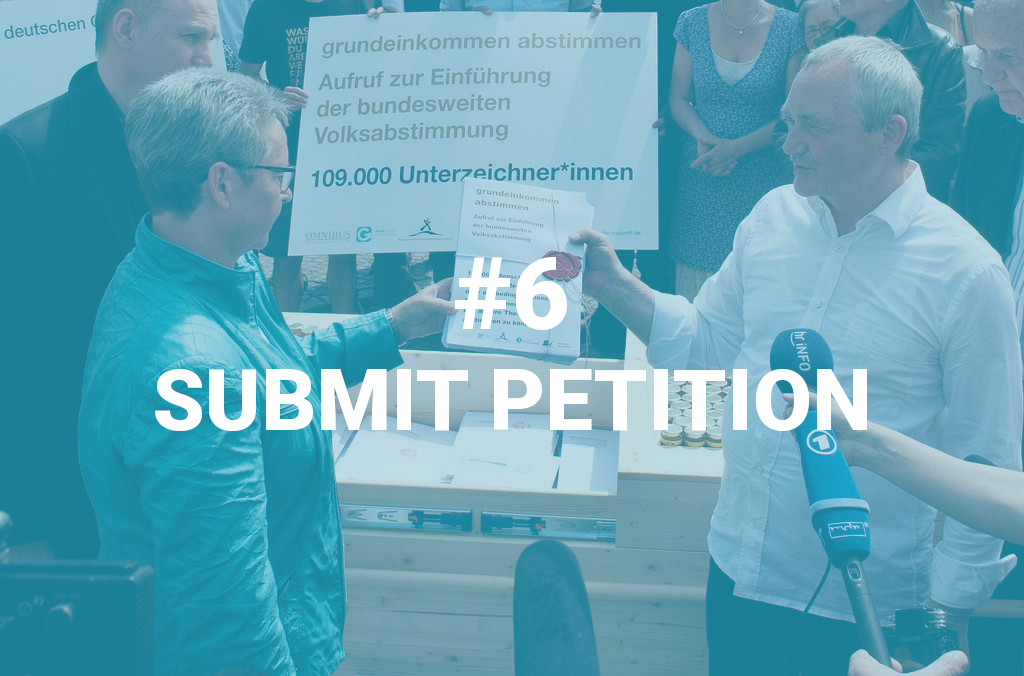
Nodošana
Jūsu petīcijas nodošanai vajadzētu būt plašsaziņas līdzekļu uzmanības piesaistošam notikumam. Jūs varat izmantot šo iespēju, lai vēlreiz pievērstu sabiedrības uzmanību savām bažām un tādējādi izdarītu spiedienu uz lēmumu pieņēmējiem.
norunāt tikšanos:
Lūdzu, laicīgi pieprasiet nodošanas datumu, jo politiķu grafiki parasti ir pārpildīti. Tāpēc, lūdzu, ņemiet vērā, ka sagatavošanās laiks ir dažas nedēļas.
Ja adresāts atsakās no tikšanās, ieteikt jaunu un, ja nepieciešams, sazināties ar vietniekiem, preses pārstāvjiem vai nodaļu vadītājiem. Pirms nodošana neizdodas, labāk ir atrast citu piemērotu personu. Iepriekšējā nodaļā mēs arī paskaidrojām, kā jūs varat palielināt spiedienu, lai notiktu personiska informācijas nodošana sabiedrībā zināmām personām.
Personīga nodošana
Uzrunātā persona tiks konfrontēta ar jūsu prasībām. Sagatavojieties nodošanai vai diskusijai par savām prasībām. Dalieties ar savu personīgo pieredzi un aiciniet savus atbalstītājus pievienoties jums nodošanas ceremonijā.
Uzaiciniet presi:
Presei tikšanās ar politiķiem un sabiedrībā pazīstamām personām ir interesantas, īpaši, ja viņi saskaras ar sarežģītiem vai jutīgiem jautājumiem. Uzaiciniet presi un fotogrāfus dažas dienas iepriekš un īsi aprakstiet, kas notiks un vai būs iespējas fotografēties. Šim nolūkam varat izmantot preses relīzi. Lūdzu, iekļaujiet saiti uz petīciju.
Sagatavot nodošanu presei:
Ja jūs varat nodrošināt labu fotografēšanās iespēju, prese būs vairāk ieinteresēta jūsu stāstā un jūsu lietā. Televīzijas stacijas nesūta filmēšanas komandas, ja nav ko skatīties. Šeit ir daži ieteikumi.:
- Izdrukājiet parakstu sarakstus un nododiet tos kā biezu “grāmatu” vai pat vairākās kastēs, kas iespaidīgi sakrājas.
- Izdrukājiet petīcijas pieprasījumu, ieskaitot petīcijas attēlu un parakstu skaitu, kā plakātu un turiet to redzamā vietā. Jūs varat lejupielādēt automātiski ģenerētu nodošanas plakātu savai petīcijai.
- Aiciniet atbalstītājus un kopīgi nododiet bažas.
- Saruna ar saņēmēju.
- Nav obligāti, bet īpaši efektīvi: sagatavošanas darbi un darbības nodošanai ekspluatācijā.
Piemēram, ar plakātu jūs vienmēr piesaistāt uzmanību un esat populārs objekts preses fotogrāfiem. Jūsu petīcijas pārvaldības sadaļā (oranžā josla pēc pieteikšanās), cilnē “Lejupielāde”, atradīsiet parakstu sarakstus drukāšanai, kā arī automātiski ģenerētu plakātu izplatīšanai. Protams, varat arī izveidot savu. Īpaši uzmanību piesaista lielformāta plakāti, kas ir iecienīts foto temats presei. Šim nolūkam varat izmantot openPetition logotipu.: Logotips ar baltu fonu , Logotips bez fona krāsas
Uzrakstiet preses relīzi
Ziņojiet par nodošanu, petīcijas prasībām, atbalstītāju skaitu un to, ko darīsiet tālāk. Preses relīzei jānonāk redakcijā ne vēlāk kā agrā pēcpusdienā, lai to varētu publicēt nākamajā dienā. Noteikti norādiet kontaktpersonas tālruņa numuru, lai ar jums varētu sazināties jautājumu gadījumā un, iespējams, pat sniegt interviju. Padomi par Preses relīze .
Ko darīt, ja neviens nevēlas pieņemt jūsu lūgumu?
Izmantojiet situāciju maksimāli. Uzņēmumu vadītāji, kuri atsakās norunāt tikšanos, lai iesniegtu apstrīdētu petīciju, jau tikai šī iemesla dēļ ir interesanti presei. Jebkurā gadījumā veiciet nodošanu! Piemēram, īrējiet telpu rātsnamā vai štata parlamentā vai izvēlieties reprezentatīvu vietu uzņēmuma galvenās mītnes priekšā. Pasniedziet parakstus tukšai krēsla personai kāda cita vārdā – tas skaidri parādīs, ka jūsu pieprasījums tiek ignorēts, un radīs spiedienu uz lēmumu pieņēmējiem. Uzaiciniet presi un fotogrāfus.
Informējiet savus atbalstītājus
Informējiet savus atbalstītājus, ka esat iesniedzis petīciju un kas notiks tālāk. Cilvēki, kas parakstījās par savu mērķi, vēlas zināt, kas noticis ar petīciju – galu galā tā ir arī viņu petīcija. Uzrakstiet emuāra ierakstu savā petīcijas lapā un nosūtiet atjauninājumu e-pastā. Noteikti attiecīgi mainiet sava lūgumraksta statusu.
Iesniegt petīciju
Papildus simboliskai nodošanai, petīcijas, kurām ir politisks raksturs, arī oficiāli jāiesniedz attiecīgajai petīciju komitejai! Jūs varat iesniegt arī lūgumrakstus vietējā līmenī valsts līmenī. Tomēr parasti ir produktīvāk meklēt dialogu ar mēriem un pilsētu vai pašvaldību padomēm. Lūdziet paziņojumu un simbolisku nodošanu.
Kā un kur es varu iesniegt savu lūgumrakstu?
Parasti lūgumrakstu var iesniegt pa pastu vai izmantojot tiešsaistes veidlapu. Noteikti norādiet savu openPetition (ar īso saiti) un parakstu skaitu.
Tiesības iesniegt lūgumrakstu Šveicē
Saskaņā ar federālo konstitūciju ikvienai Šveices pilsonei ir tiesības iesniegt lūgumrakstu varas iestādei. Iestādei ir jāņem vērā lūgums. Parakstus var vākt gan uz papīra, gan tiešsaistē. Nav kvoruma, nav minimālā parakstu skaita un nav laika ierobežojuma. Federālā līmeņa petīciju iesniedzējam vismaz divas nedēļas pirms plānotās petīcijas iesniegšanas jāsazinās ar Federālās kancelejas Politisko tiesību nodaļas sekretariātu un jāvienojas par tikšanos. Tas ir absolūti nepieciešams, jo petīciju federālā līmenī var iesniegt tikai Bernes federālajā terasē. Gleznainā vidē petīcijas Federālajai kancelejai bieži tiek iesniegtas plašsaziņas līdzekļiem efektīvā veidā, preses pārstāvju pavadībā. Katram kantonam ir sava procedūra lūgumrakstu iesniegšanai kantonu līmenī.
populāra iniciatīvair vēl viens instruments pilsoņu līdzdalībai Šveicē. Tas tiek veikts arī kā lūgumraksts. Tomēr federālā līmenī tautas iniciatīva var atsaukties tikai uz federālo konstitūciju. To var ierosināt tikai balsstiesīgi pilsoņi, un uz to attiecas arī stingrāki noteikumi nekā uz petīciju. Ja šie nosacījumi tiks izpildīti, tiks rīkota valsts mēroga referenduma.
Lūgumrakstu iesniegšanas tiesības ES
Tiesības iesniegt lūgumrakstu ir nostiprinātas ES Pamattiesību hartas 44. pantā. Lūgumrakstu Eiropas Parlamentam var iesniegt jebkurš ES pilsonis un jebkura juridiska vai fiziska persona, kas ir reģistrēta ES. Tomēr priekšnoteikums ir tāds, ka lūgumraksta priekšmetam ir jābūt ES kompetencē un tam ir tieši jāietekmē lūgumraksta iesniedzēji. Lūgumrakstā var izklāstīt individuālu lūgumu, sūdzību vai novērojumu par ES tiesību aktu piemērošanu. Arī Eiropas Parlamentam var tikt lūgts sniegt komentārus par konkrētu jautājumu. Šādi lūgumraksti dod Eiropas Parlamentam iespēju reaģēt uz Savienības pilsoņu tiesību pārkāpumiem, ko izdarījusi dalībvalsts vai ES iestāde.
Lūgumrakstus Eiropas Parlamentam var iesniegt rakstiski pa pastu, tiešsaistē Eiropas Parlamenta tīmekļa vietnē vai pa e-pastu. Eiropas Parlaments katru gadu saņem aptuveni 1000 lūgumrakstu.
SEKOT LĪDZI!
Pēc nodošanas turpiniet strādāt pie sava pieprasījuma izpildes. Uzturiet saziņu ar saņēmējiem, presi un saviem atbalstītājiem. Nodošanas laikā uzņemiet fotoattēlus un video un ievietojiet tos sociālajos tīklos, lai apliecinātu savu apņemšanos un informētu sabiedrību par savu mērķi.
Regulāri publicējot ierakstus petīcijas emuārā, jūs varat informēt visus jūsu petīcijas atbalstītājus, paziņot par pasākumiem, informēt par progresu vai dalīties ar petīcijas panākumiem. Šī funkcija paliek pieejama vienu gadu pat pēc iesniegto lūgumrakstu iesniegšanas. Tāpat noteikti atjauniniet sava petīcijas statusu, lai atbalstītāji zinātu, kad tā ir iesniegta, un, iespējams, pat to, vai tā ir bijusi veiksmīga!
Atbalsts, izmantojot openPetition: Mēs jūs atbalstīsim visos šajos soļos. Ir svarīgi, lai jūs mūs informētu. Ja pamanīsim, ka esat stingri apņēmies, tad arī mēs uzticēsimies jums. Piemēram, ja mēs uzzinām par plānotu nodošanu, mēs varam jūs par to informēt un, ja nepieciešams, izmantot mūsu kanālus.